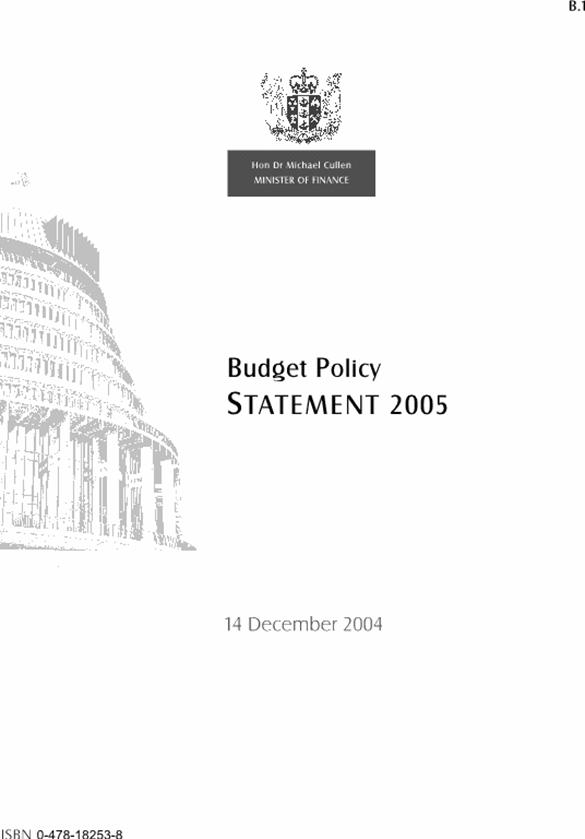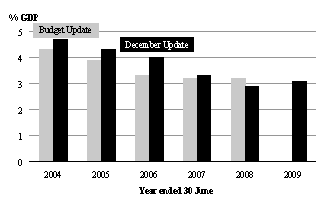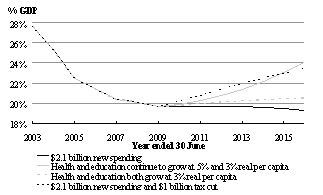Exhibit 99.c(2)

The Public Finance (State Sector Management) Bill
This Bill integrates the Fiscal Responsibility Act (FRA) into the Public Finance Act. This will consolidate the legislation regarding public finances. As well as incorporating additional measures to improve transparency, the Bill proposes changes to distinguish the Budget Policy Statement (BPS) and Fiscal Strategy Report (FSR).
As outlined in the 2004 FSR, under the existing reporting requirements the BPS tends to be quite broad in scope and similar to the FSR in content. The Bill removes the requirement for every BPS to cover high-level fiscal strategy, except if the Government is explicitly changing it. Under new legislation the BPS will instead focus more on the priorities for the upcoming Budget. It will be required to outline the overarching policy goals that will guide Budget decisions and the policy areas that the Budget will focus on. The BPS will also be required to state how the Budget accords with the Government’s short-term fiscal intentions.
The Bill is likely to be passed in December 2004. The 2005 BPS has been drafted taking into account the requirements of both the FRA and the Public Finance (State Sector Management) Bill.
The Bill also supports greater transparency through a new requirement to include a statement of tax policy changes in the Budget Economic & Fiscal Update. It also requires the Treasury to prepare a statement at least every four years on the long-term fiscal situation. The Bill requires the 2004/05 Supplementary Estimates to be prepared on the basis of the Public Finance Act 1989 and the 2005/06 Main Estimates to be prepared on the basis of the Bill.
Budget Policy Statement
Introduction
The 2005 Budget Policy Statement (BPS) sets out the overarching fiscal parameters that will guide Budget 2005, and outlines the Government’s policy focus.
Our fiscal strategy is unchanged from the 2004 Fiscal Strategy Report (FSR). We will continue to meet our long-term fiscal objectives:
• maintain debt at prudent levels, with gross sovereign-issued debt slowly reducing as a percentage of GDP over the longer term and passing through 20% of GDP before 2015
• run operating surpluses on average across the economic cycle sufficient to meet New Zealand Superannuation (NZS) Fund contributions, and
• meet capital pressures and priorities.
The Government has proved itself a capable economic manager…
The Government’s objective is to increase New Zealand’s long-term sustainable rate of economic growth and to ensure the benefits of growth are spread across society. To provide a solid foundation to enable this to happen, we have ensured that the public finances are managed prudently to a set of long term fiscal outcomes, and managed in a stable and consistent way that does not change long-term objectives with changes in the short-term outlook. This enables businesses to plan for the long-term without the uncertainty of unpredictable government policy, and individuals to be more confident that the government will be able to deliver social services into the future.
Lowering debt as a percentage of GDP strengthens the fiscal position to cope better with future fiscal pressures, including the effects of an ageing population on New Zealand Superannuation and health spending. To help cover the expected superannuation cost we are building up assets in the NZS Fund, which will reach $15.5 billion in June 2008. We have reduced gross sovereign-issued debt from 35.4% of GDP in 1999 to 25.3% in 2004 and a forecast 20.1% of GDP in 2008. The combination of building up assets and debt reduction has resulted in a strong improvement in net debt from 20.9% of GDP in 1999 to 8.0% in 2004 including NZS Fund assets and a forecast minus 1.4% in 2008 (ie, a net financial asset position). The strengthened fiscal position improves our ability to raise debt in the future if necessary, and provides us with time to assess the impact of the demographic changes and to develop and implement policy responses.
… whilst making significant progress against its objectives.
We have achieved this progress in building a robust long-term fiscal position at the same time as advancing the Government’s overall economic and social objectives. During the Labour-led Government’s second term we have introduced a range of initiatives that will support long-term growth, beyond simply providing a sound fiscal position. Specific support to business through the Growth and Innovation Framework, including export and investment promotion; investments to improve human capital and large capital investments in infrastructure, will all help foster growth.
At the same time we have been able to deliver on our social objectives. We have introduced initiatives to build safer communities; put further resources into the environment and conservation; made investments in housing; invested to improve public services and the capability of government agencies; and delivered a sizeable social dividend through the Working for Families package introduced in Budget 2004. The effect of many of these initiatives is still feeding through. The Working for Families package will be phased in over the coming three years rising to $1.1 billion, boosting incomes for low and middle-income families.
Budget 2005
Budget decisions will be guided by our overarching policy goals.
Within Budget 2005 we will continue to manage our fiscal position consistent with our long-term objectives whilst progressing our overall social and economic objectives. The overarching policy goals that will guide our budget decisions continue to be:
• the maintenance of fiscal and economic responsibility, committed to building sufficient headroom to cope with future economic shocks and longer term fiscal pressures
• ensuring a fair society that values the wellbeing of its members and what it means to be a New Zealander, and
• improving New Zealand’s economic performance so as to improve the living standards of New Zealanders and create opportunities for all.
Our overarching policy goals will determine the overall size of Budget 2005, and priority areas for spending.
We will prepare Budget 2005 on the basis of maintaining a responsible approach to fiscal policy.
Our long-term objective of gross sovereign-issued debt slowly falling as a percentage of GDP, passing through 20% before 2015, remains our ultimate anchor in setting fiscal policy. We also ensure that our budget decisions are built upon a set of sensible assumptions, such as trend economic growth in New Zealand of 3% per annum and constant tax to GDP. It is prudent to make decisions based on realistic or even conservative assumptions, as we do not want to leave the fiscal position vulnerable to future shocks because of over-optimism.
The level of spending that is consistent with meeting our long-term debt objective will depend upon the level of taxes. Beyond the forecast period, the projections assume that tax to GDP will be constant. The “Long-Term Fiscal Scenarios” box outlines the implications for debt as a percentage of GDP under different assumptions.
New information shows we have scope to increase spending...
Under the fiscal management approach we review our spending intentions in the light of updated economic and fiscal forecasts and our long-term fiscal objectives. Since the 2004 Budget Economic and Fiscal Update (Budget Update) we have seen evidence that the economy has performed more strongly in 2004 than expected in the Budget Update forecasts, including higher-than-expected tax revenues and lower-than-expected benefit expenses as unemployment has fallen. The Treasury is now forecasting economic growth for the 2004/05 March year to be 4.7% though expects that a range of factors will combine to slow growth into the next year.
In addition to higher-than-expected tax outturns, the Government’s recent decision on Thin Capitalisation Rules for Banks is estimated to boost tax revenues by $240 million in 2005/06 and $360 million thereafter.
On the basis of new economic forecasts and this policy change, Treasury’s tax forecasts have been revised up since Budget Update. At this stage it appears that this revision includes a structural increase in revenue beyond the effect of the “Thin Capitalisation” policy change. This suggests we have the ability to increase our new operating spending intentions for Budget 2005 beyond the $1.8 billion signalled in the 2004 FSR.
… but to be prudent we also need to recognise a number of uncertainties.
In deciding on a level of spending consistent with our long-term debt objective, however, we are also aware we need to take into account a number of other factors and uncertainties around:
• the current structural fiscal position and trend economic growth, and the inherent risks around forecasts. It is prudent not to spend an increase in revenue that results from cyclical factors.
• the state of the economy and any possible monetary policy response. We will seek to avoid a fiscal expansion that puts undue pressure on interest and exchange rates.
• other demands on the operating surplus. The entire surplus is not available for new spending. It is needed to finance the build up of assets (including the NZS Fund and advances to District Health Boards and student loans) and the Government’s capital programme (for example, constructing roads).
• awareness of underlying spending pressures into the future. For example, health spending has been rising by around 5% in real terms per person per year since 1999.
Budget 2005 will spend a little more than earlier signalled...
Taking all of this into account, the December Economic and Fiscal Update (December Update) forecasts incorporate an allocation for new operating spending net of any revenue and savings initiatives (eg, Thin Capitalisation Rules for Banks) in Budget 2005 of
$2.1 billion in 2005/06, rising to $2.2 billion in 2006/07 and $2.4 billion thereafter. Further assessments of trends in revenue, expenditure, economic growth and their combined impacts on the debt track could influence final decisions on the Budget. On current forecasts we have scope for additional spending in the short-term beyond that signalled here, while still meeting our debt objective. But the risks around the current macroeconomic position and long-term spending pressures mean any further initiatives should not be stimulatory and should be at least fiscally neutral over the long term. Options may relate to business, savings or prefunding initiatives. The total quantum of the final Budget package will ensure the government is still on track to meet its long-term debt objective and achieve its short-term fiscal intentions of running operating surpluses, excluding net NZS Fund returns, of around 3% of GDP.
…enabling us to advance the Government’s strategic priorities…
Within this package we will advance our social and economic priorities to help New Zealanders to achieve the quality of life they want. We expect to progress our overarching goals for Budget 2005 across a number of policy areas.
… ensuring a fair society where everyone benefits...
Building on the ongoing impact of the Working for Families package, we shall introduce further measures to ensure that everyone has the opportunity to benefit from New Zealand’s economic growth. We shall advance a range of initiatives that support further social development, recognising the value New Zealanders place on living in a fair and equitable society. We will pay special attention to policies that could build the asset base and savings capacity of New Zealanders, including responding to the recommendations of the recent report Toward Consensus on the Taxation of Investment Income.
Security is important if people are to feel confident to invest in their future and their businesses. To ensure we live in safer communities we will continue our investment into the justice sector so that it is well equipped to contribute to a safe and fair society. International security and defence will be another important dimension of this.
The health sector remains a key priority for this Government. We will build on the substantial investment made in previous budgets that supports a comprehensive and high quality health service for New Zealanders.
Budget 2005 will also reflect this Government’s recognition of the value of New Zealand’s unique environment, culture, heritage and lifestyle.
… and lifting economic growth.
We will continue to place emphasis on improving New Zealand’s economic performance by providing a solid fiscal foundation and fostering an innovative and creative society. Our commitment to the growth and innovation of business in New Zealand will continue. We will look for new opportunities to foster an environment that supports innovation, investment in research and development and the growth of enterprising businesses.
To boost our sustainable rate of economic growth we will also look for ways to support labour productivity growth. An important requirement is that New Zealand has a skilled and well-educated workforce, and that businesses are able to access the skills they need.
We will continue to stress the importance of the education sector, considering opportunities to strengthen education outcomes through high quality education services.
We will balance pressures on net operating spending, NZS Fund, and capital investment.
Budget decisions go beyond decisions about net operating spending but also require decisions about capital injections and asset accumulation consistent with our long-term debt objective. The operating surplus is used to assist in financing the build up of assets (for example, contributions to the NZS Fund and advances to District Health Boards, and student loans) and to fund the Government’s capital programme (for example, constructing roads, replacing hospital facilities, building prisons and reequipping the defence forces). Because of these other fiscal policy needs, in some years the Government still needs to borrow in spite of apparently large operating surpluses. As a result, nominal debt can increase even when there is an operating surplus.
In preparing for Budget 2005 we have considered our priorities across these items, including the importance we place on further capital investment. In addition to net new expenditure indicated above, in Budget 2005 we will:
• meet our commitments to the NZS Fund ($2.2 billion in 2005/06), and
• increase the remaining capital provisions in 2005/06 and 2006/07 to reflect the priority given to capital investment, taking new capital spending over the next four years to $2.9 billion.
Figure 1 – Use of OBERAC

Source: The Treasury
Figure 1 illustrates how the operating balance excluding revaluations and accounting policy changes (OBERAC) is used in each year of the forecast horizon. From 2005/06 nominal debt has to increase to fund policy priorities.
Beyond Budget 2005
To be prudent we also need to think beyond Budget 2005.
Budget 2005 will be smaller than the Government’s flagship 2004 Budget of $3.8 billion of new operating spending, in order to meet our long-term debt objective. To achieve this objective we cannot think about Budget 2005 in isolation but need to develop our short-term fiscal strategy in the context of future Budgets. In the 2004 FSR we noted that with constant tax-to-GDP, core expenses-to-GDP would need to remain around 32% if we are to achieve our debt objective. To achieve this future budgets will also need to be smaller than Budget 2004 and similar in size to Budget 2005.
We previously indicated budgets from 2006 in the order of $1.6 billion. Looking over the longer term we see a number of spending pressures already evident. The core spending areas of health and education are taking an increasing portion of the Budget each year. A continuation of recent rates of growth in spending in core services would be inconsistent with meeting the Government’s debt objective. Furthermore it would crowd out funding for other key priorities such as growth and innovation and social development and housing. The “Long-Term Fiscal Scenarios” box considers the implications for the debt objective of several scenarios, including this one.
To be responsible in this BPS we have revised up our allocation for future new operating spending to better account for likely spending pressures. The new indicative allocation is $2.1 billion new spending for Budget 2006, $2.2 billion for Budget 2007, and $2.3 billion for Budget 2008. This recognises the growing cost of maintaining current policies, whilst enabling some room for new initiatives.
Figure 2 – OBERAC

Source: The Treasury
Under this approach we will meet our long-term fiscal objectives.
The balance of net new spending indicated for Budget 2005, the revised revenue position, and revisions to the indicative size of future Budgets, suggests the OBERAC as a percentage of GDP will be higher in 2005/06 than forecast in the Budget Update, similar in 2006/07 but slightly lower in 2007/08.
Figure 3 – Gross debt

Source: The Treasury
Combining the track of forecast surpluses with NZS Fund contributions and planned capital investment, suggests that gross debt-to-GDP will be lower throughout the forecast period than was forecast in the 2004 Budget Update. This is due to the stronger 2003/04 and 2004/05 operating balances. Under the assumptions here, gross debt would pass through 20% in 2008/09. To achieve this core expenses-to-GDP average 31.5% over the forecast period.
Long-Term Fiscal Scenarios
December Update forecasts show gross debt falling to 19.6% of GDP in 2008/09. But it is important to keep the longer-term fiscal picture in mind when making short-term decisions as some decisions may require associated costs in future budgets. Illustrative scenarios beyond 2009 can identify how different spending patterns would affect gross debt-to-GDP.
An operating allowance for new spending of $2.1 billion throughout the projection period (1) would see gross debt remain virtually flat at around 19.5% of GDP out to 2015/16. Smaller budgets would see debt continue to trend down relative to GDP in line with our long-term objective. But budget increases larger than $2.1 billion would result in debt-to-GDP rising throughout the projection period. It is important to ensure that the debt ratio does not start rising during this period of relatively stable demographics. A higher debt ratio would reduce the Government’s flexibility to cope with the fiscal pressures coming from substantial demographic change as we would enter that period with higher expenses-to-GDP and rising debt-to-GDP.
An alternative approach to modelling top-down budget amounts is to build a picture of spending into the future on the basis of recent trends in each area. Since 1999 health spending has grown in real terms by 5% per capita per annum, while education spending has grown at a real 3% per capita per annum. If these growth rates were to continue over the projection period, and other spending grow in line with nominal GDP, then the result would be debt-to-GDP rising throughout the projection period to 24% by 2016.
Figure 4 – Impact on debt-to-GDP of different spending scenarios

Source: The Treasury
If growth in health spending was instead contained to 3% in real per capita terms, the debt-to-GDP ratio would remain relatively flat (though slightly higher than in the $2.1 billion scenario). But if total spending levels were held so that the debt ratio did not rise, even 3% growth in health and education spending would squeeze out other priority spending.
A final scenario is to consider the impact of a $1 billion tax cut while maintaining new spending of $2.1 billion through the projection period. In this circumstance gross debt-to-GDP would rise to over 23% by 2016. If the Government is to deliver tax cuts and still meet its long-term debt objective, then new spending would have to be lower. This would require limiting spending growth well below current rates.
(1) Because these projections cover a time period well beyond the short-term fiscal forecasts, the new spending assumption is increased to reflect growth in nominal GDP.
These scenarios indicate that the fiscal position is more constrained than simply looking at the debt track for the forecast period would suggest. The 2005 FSR will contain a fuller analysis of long term projections.
Conclusion
Our fiscal strategy has not changed from the 2004 FSR. We remain committed to running operating surpluses on average across the economic cycle sufficient to meet NZS Fund contributions, while meeting capital pressures and reducing gross sovereign-issued debt as a percentage of GDP over the longer term.
In preparing Budget 2005 our budget decisions are guided by our overarching policy goals of maintaining a responsible fiscal and economic approach; ensuring a fair society that values the wellbeing of its members; and improving New Zealand’s economic performance so as to improve the living standards of New Zealanders. Taking into account latest economic and tax forecasts, and recognising the inherent risks around the forecasts, the state of the economy, other demands on the operating surplus, and underlying spending pressures looking into the future, we have scope to increase spending beyond that previously indicated.
The Government has consistently managed a path of balancing a prudent fiscal stance and progressing our policy priorities. Budget 2005 will continue this approach. We are continuing to build a solid economic and social future for New Zealand.
/s/ Michael Cullen | | |
Hon Dr Michael Cullen | |
Minister of Finance | |
| |
| |
6 December 2004 | |
Annex: Long-term Fiscal Objectives and Short-term Fiscal Intentions
The Government’s long-term fiscal objectives are unchanged from the 2004 FSR.
Table A1 – Long-term fiscal objectives
Long-term fiscal objectives | | To achieve the objectives of fiscal policy, the
Government’s high-level focus is on: |
Operating balance: Operating surplus on average over the economic cycle sufficient to meet the requirements for contributions to the NZS Fund and ensure consistency with the long-term debt objective. Revenue: Ensure sufficient revenue to meet the operating balance objective. Expenses: Ensure expenses are consistent with the operating balance objective. | | • Operating surpluses (measured by the OBERAC) during the build-up phase of the NZS Fund. The focus is on core Crown revenues and expenses, with tax-to-GDP and core Crown expenses-to-GDP around current levels. • Because the OBERAC surplus includes the net (after-tax) return on the NZS Fund, which the NZS Fund will retain, the Government is effectively targeting OBERAC surpluses excluding the NZS Fund’s retained investment returns. • A robust, broad-based tax system that raises revenue in a fair and efficient way. • State Owned Enterprises (SOEs) and Crown entities contributing to surpluses, consistent with their legislation and Government policy. |
| | |
Debt: Manage total debt at prudent levels. Gross sovereign-issued debt as a percentage of GDP slowly reducing over the longer term and passing through 20% of GDP before 2015. | | • SOEs will have debt structures that reflect best commercial practice. Changes in the level of debt will reflect specific circumstances. • Gross sovereign-issued debt-to-GDP will be reducing during the period ahead of the major demographic changes associated with population ageing. • Net debt, with NZS Fund assets, is expected to fall towards minus 15% of GDP by 2015 (ie, a net financial asset position). |
| | |
Net worth: Increase net worth consistent with the operating balance objective. | | • Increasing net worth consistent with the operating balance objective will see net worth at above 50% of GDP by 2015. • The NZS Fund is expected to be 21% of GDP by 2015. • Consistent with the net worth objective, there will also be a focus on quality investment. |
Table A2 – Short term fiscal intentions
2005 Budget Policy Statement | | 2004 Fiscal Strategy Report | |
Based on operating amounts for the 2005 Budget, and indicative amounts for the next two Budgets, the operating surplus on an OBERAC basis and excluding net returns on the NZS Fund will be around 3% of GDP, remaining consistent with the long-term objective for the operating balance. | | Based on operating amounts for the 2004 Budget, and indicative amounts for the next two Budgets, the operating surplus on an OBERAC basis and excluding net returns on the NZS Fund will be around 3% of GDP, remaining consistent with the long-term objective for the operating balance. | |
| | | |
Gross sovereign-issued debt is forecast to be 19.6% of GDP in 2008/09. | | Gross sovereign-issued debt is forecast to be 21.8% of GDP in 2007/08. | |
| | | |
The Government will set forecast new capital spending amounts that ensure progress is made toward the long-term objective for debt. The Government’s bias is towards debt-to-GDP trending down over time. | | The Government will set forecast new capital spending amounts that ensure progress is made toward the long-term objective for debt. The Government’s bias is towards debt-to-GDP trending down over time. | |
| | | |
Net debt excluding NZS Fund assets is forecast to be 7.4% of GDP in 2008/09; including NZS Fund assets -3.2% in 2008/09. | | Net debt with NZS Fund assets consistently falling as a share of GDP. Net debt with NZS Fund assets is forecast to be -0.2% of GDP in 2007/08. | |
| | | |
Total Crown expenses are forecast to be 41.0% of GDP in 2008/09. | | Total Crown expenses are forecast to be 40.0% of GDP in 2007/08. | |
| | | |
Core Crown expenses are forecast to average 31.5% over the forecast period and be 32.3% of GDP in 2008/09. | | Core Crown expenses are forecast to be 31.6% of GDP in 2007/08. | |
| | | |
This assumes new operating expense amounts of $2.4 billion; $2.1 billion; $2.2 billion; and $2.3 billion for the 2005, 2006, 2007 and 2008 Budgets respectively. | | This is based on new operating expense amounts of $1.8 billion; $1.6 billion; and $1.6 billion for the 2005, 2006 and 2007 Budgets respectively. | |
| | | |
Total Crown revenues are forecast to be 44.0% of GDP in 2008/09. Within this, core Crown revenues are forecast to be 34.3% of GDP in 2008/09. | | Total Crown revenues are forecast to be 43.1% of GDP in 2007/08. Within this, core Crown revenues are forecast to be 33.8% of GDP in 2007/08. | |
| | | |
The Government will set revenue plans that ensure progress is made towards the long-term revenue objective. | | The Government will set revenue plans that ensure progress is made towards the long-term revenue objective. | |
| | | |
Net worth is forecast to be 35.4% of GDP in 2008/09, including NZS Fund assets of 10.6% of GDP. | | Net worth is forecast to be 30.5% of GDP, including NZS Fund assets of 9.3% of GDP in 2007/08. | |




